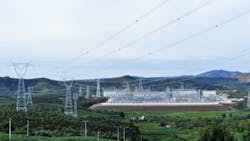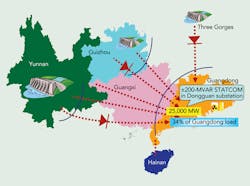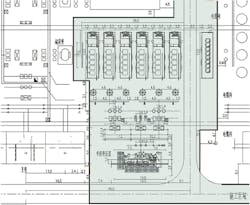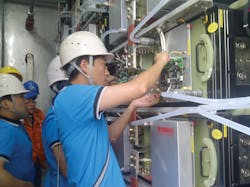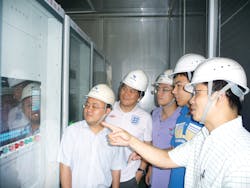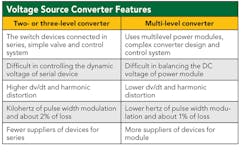The largest and most important power center in terms of total energy consumption supplied by China Southern Power Grid is the Pearl River Delta region. The economics and industry in this region, still developing at an increasing rate, play an important role in China. The four main large cities in this region are Guangzhou, Shenzhen, Dongguan and Foshan, and the demand in each city exceeds 10,000 MW.
For the Pearl River Delta region, China Southern Power Grid (CSG) has constructed a long-distance ultrahigh-voltage (UHV) hybrid alternating-current/direct-current (AD/DC) power grid comprising eight 500-kVAC overhead lines, four high-voltage DC (HVDC) links (±500 kV, 3,000 MW) and one 1,418-km (881-mile) UHVDC link (±800 kV, 5,000 MW), which have, in total, a west-to-east load-transfer capacity of more than 25,000 MW. Therefore, dynamic reactive power demand and voltage stability are paramount to ensuring the supply of electrical energy to this region.
As the electric utility industry is developing rapidly to keep pace with China’s growing economy, there is an increasing demand for high-quality services. CSG’s response is to establish a strategy to provide a source of energy that is intelligent, efficient, reliable and generated by renewable energy sources, that is, green power.
System Control and Reliability Studies
A member of the flexible ac transmission system (FACTS) family of devices, the static synchronous compensator (STATCOM) can enhance transmission system control, reliability and operation, and improve system power quality. For CSG’s load center in the East, a STATCOM could significantly help with voltage recovery following faults in the eastern sector of the CSG service territory and also prevent failure of the HVDCs’ serial commutation.
Control and reliability studies were required to determine the optimum location for installing a STATCOM and what the capacity of the unit should be. The Electric Power Research Institute of CSG (EPRI-CSG) undertook in-depth, detailed studies that considered different operational modes, system development and hybrid AC/DC operation. The studies revealed the most severe system fault that could occur was a three-phase fault where a link circuit breaker failed to open.
The studies indicated that the best place for a STATCOM to be installed was either in the 500-kV Dongguan substation or in the 500-kV Hengli substation. When determining the required capacity of the STATCOM, CSG had to consider the conditions of each substation as well as the age of its equipment. After much consideration, CSG decided to install a ±200-MVAR STATCOM in its 500-kV Dongguan substation.
From 2007 to 2010, CSG, along with Rongxin Power Electronic Co. and Tsinghua University, established a consortium project to undertake the research and development of the 200-MVAR STATCOM.
STATCOM Main Circuit and Topology
The group recommended the STATCOM be connected to the 35-kV bus instead of the 10-kV bus to reduce the output current required and the losses. The study group also compared the preferred connecting modes, star and delta. In the star mode, the phase voltage was lower in steady-state while the three-phase voltages were different and probably much higher than rated value in unbalanced working condition. In contrast, in the delta mode, there were different current outputs in unbalanced conditions with no higher-phase voltages. Based on these findings, a STATCOM with delta connections was selected.
Considering the technology challenge and device’s limitation, the STATCOM is designed to be ±200 MVAR, with two ±100-MVAR voltage source converters (VSCs). VSCs are the kernel technology for the STATCOM; normally, there are two- or three-level converters and multilevel VSC applications.
Because of the limitation of the device and the expectation of achieving improved performance, the VSC is built up with H-bridge modules connected in series that use the injection-enhanced gate transistor devices. Each phase has 26 modules with two for redundancy to output 53 levels of voltage. With the high levels of voltage, the frequency of the pulse-width modulation (PWM) is only 250 Hz and, thus, provides very good performance regarding harmonic distortion and loss control.
Control Strategy
According to system requirements, the STATCOM is designed with two control modes: a reactive power control mode and a voltage control mode. The reactive power control mode makes it easy to test the basic function of the STATCOM, while the voltage control mode is used in normal operation.
To achieve a fast response time, the instantaneous current controller is designed to control the three-phase output current separately. Furthermore, the controller also can deal with unbalanced fault conditions without tripping.
Real Time Digital Simulator Test
The Real Time Digital Simulator, equipment designed and manufactured by RTDS Technologies Inc., was used for fast, reliable, accurate and cost-effective power system simulation studies of the technology with CSG’s complex HVAC and HVDC networks. Since the RTDS simulator is a fully digital electromagnetic transient power system simulator that operates in real time, EPRI-CSG developed the simulation model with the STATCOM and the hybrid HVAC and HVDC systems. The STATCOM control and protection system was connected to the simulator to undertake the functional performance test and dynamic performance test.
From Oct. 27, 2010, through Jan. 14, 2011, CSG tested six classes with 52 items in its simulator laboratory. During testing, engineers checked and improved the control and protection logic and performance.
Commissioning Testing
The STATCOM project required the expansion of an existing substation. To reduce the construction period, equipment was installed in containers chosen for the layout. Each phase of both VSCs is installed in a single container together with the water-cooling system. Together with the system control container, there are seven 12.2-m by 3.2-m (40-ft by 10.5-ft) containers installed at the substation.
The commissioning testing took place from July 26, 2011, through Aug. 8, 2011, in a program that included 10 tests each of 28 items. The test results confirmed the following performance characteristics:
- The STATCOM has a very fast response time. The reactive power output of a single VSC was set to jump from-40 MVAR to +40 MVAR, and the response time was less than 5 msec. Considering the fault-detection time, the STATCOM can output from -200 MVAR to +200 MVAR in about 15 msec.
- With low PWM frequency, the STATCOM losses are 1.05% in full load conditions, without the connection transformer. That is a significant contribution to reduce the running costs as the output is almost zero in normal operation especially when compared with the SVC. For a 200 MVAR compensator, the running cost of the STATCOM losses is only one-third of the static volt-ampere-reactive compensator (SVC), which offsets the difference in project investment.
- The harmonic distortion of the 35-kV bus is less than 2.5%, with a single VSC having an output of 50 MVAR. During the commissioning tests, the output of the STATCOM had little impact on the 220-kV total harmonic distortion.
- The fault on the power module was simulated to test the redundancy strategy. The module is bypassed when there is a fault, and the converter is blocked. After 250 msec, the converter is de-blocked and reactive power output restored.
- The two converters are controlled by a single controller, and thus, there is synchronous output in steady-state and transient-state conditions.
One Year of Special Operation
Following the commissioning tests on the world’s largest and most powerful STATCOM, it entered service on Aug. 19, 2011, in the 500-kV Dongguan substation. It operated for a year before entering into commercial operation, in accordance with CSG regulations.
During that year, further tests were executed, including an overload test and system fault test. These two tests reflect the transient performance of the STATCOM and show how the operating characteristics can improve power system stability.
Remarkable Benefits
The construction and operation of the ±200-MVAR STATCOM project has resulted in remarkable and comprehensive benefits. The success of this project represents an important milestone in STATCOM development and system application in China and even in the global electric power industry. It provides a solid foundation for subsequent projects in terms of the research, manufacturing, development, design and operation of hundreds of MVAR STATCOMs in China.
The ±200-MVAR STATCOM in CSG will play an important role in the event of system faults for voltage support, preventing HVDC serial commutation failure. Therefore, the STATCOM will help CSG to increase the power transfer capacity from west to east through the HVDC system, reducing the need for further investment in the power grid.
According to the utility’s system development studies, there will be 20 HVDC systems in CSG by 2030, 12 of which will be located in the Pearl River Delta region. An additional eight HVDC circuits will be constructed in the region, supported by 15,000-MVAR STATCOM capacity. Assuming the capacity of the STATCOMs will increase to 300-MVAR units, there will be an additional 50 STATCOMs in service in CSG by 2030.
Hong Rao ([email protected]) received his bachelor’s degree from Huazhong University of Science and Technology of China in 1983. From 1983 to 2003, he was engaged in power system design and project construction. Rao was appointed chief engineer of the Electric Power Research Institute of China Southern Grid in 2003 and is now vice president.
Shukai Xu received his bachelor’s degree in 2002 and Ph.D. degree in 2007, both from Tsinghua University. Currently, he is a senior engineer and project manager in electrical engineering in the Electric Power Research Institute of China Southern Grid. Xu’s specialist list of interests includes power electronics research and project construction, especially flexible ac transmission systems, voltage source converters and high-voltage direct-current systems.
Companies mentioned:
China Southern Power Grid | http://eng.csg.cn
Rongxin Power Electronic Co. | http://en.rxpe.com
RTDS Technologies | www.rtds.com
Tsinghua University | www.tsinghua.edu.cn
